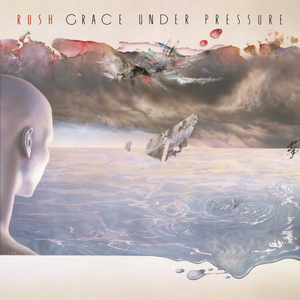Grace Under Pressure arrived at the height of ‘80s silliness, and a glance at the back cover provides proof. Synthesizers were now at the forefront of the mix, alongside guitars that were even further from prog. Hindsight has been kinder to the album than we were at the time, enthralled as we still were with Moving Pictures. The new album seemed almost too slick, too shiny; but again, if this was your high school soundtrack, your reaction would have been different.
To their credit, each of the songs does indeed explore, vividly, the concepts of human stress—not in the egomaniacal Dark Side Of The Moon sense, but more what non-rock stars must endure on a daily basis in so-called modern society. The album starts with a moment of “2112” wind and then “Distant Early Warning” (commencing a worrying trend of not having the title mentioned in the song itself, making it tough to request on the radio) echoes the contemporary nuclear worry prevalent in 1984, yet dares to hint at the notion of a romantic relationship. “Afterimage” goes right to the point, reflecting on a recently deceased friend, and not at all mawkishly; rather, the urgency in the riff conveys anger at what/who was lost. “Red Sector A” is divisive, being as it sports what we’d still call a disco beat, but it’s paired a compelling lyric, evocative of the Holocaust, which Geddy Lee’s parents survived. “The Enemy Within” is said to be part one of the completed “Fear” trilogy, which began two studio albums before, continuing the reggae beat from the second part (and from “Vital Signs”). Each installment is thus less interesting than the last.
A somewhat robotic beat fittingly but annoyingly inaugurates “The Body Electric”, accompanied by percolating bass and more unresolved chords; as with much of the album, the chorus is the best part. “Kid Gloves” has a dizzying, cyclical riff in 5/4 that calms down for the choruses, and reading the lyrics now, they come off as something of a comfort for the confused teen mindset depicted in “Subdivisions”. The edgy “Red Lenses”—listed in lowercase and demonstrative color type in all documentation—is loaded with plays on the word and simple rhymes. Finally, “Between The Wheels” employs a suitably tense synth bed, hints at a chance of perseverance with a driving chorus, but reverts to the tension to reflect the cycle.
It’s not one of our go-to Rush albums, so we’re always surprised how listenable Grace Under Pressure turns out to be whenever we throw it on. Still, it’s a long way from the yowls and sorcery of the previous decade, and does show that while the band may no longer be considered progressive, they have progressed.
Rush Grace Under Pressure (1984)—3

No comments:
Post a Comment